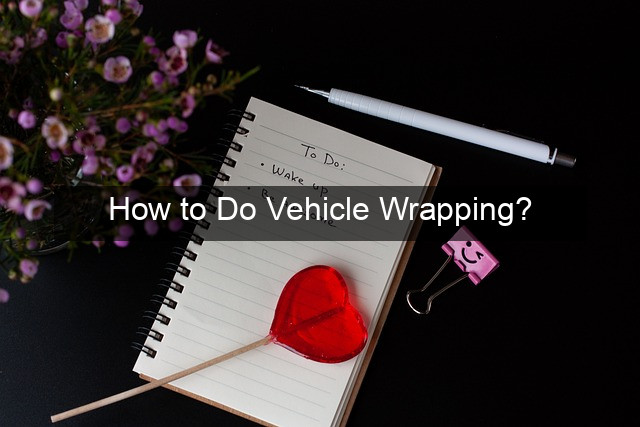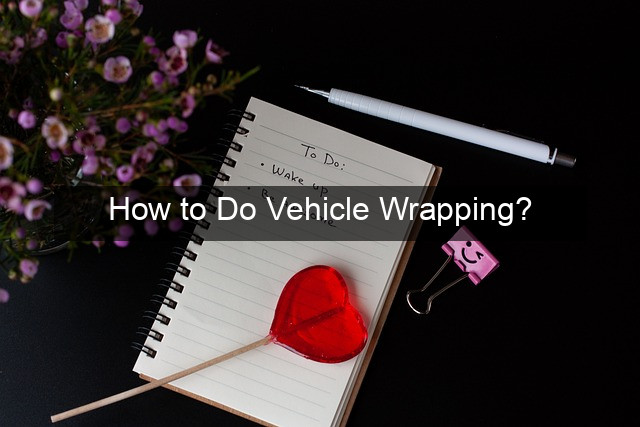How to Do Vehicle Wrapping?

- How to Do Vehicle Wrapping?
- Transform Your Ride: A Comprehensive Guide to Vehicle Wrapping
- Preparing for the Wrap
- Cleaning and Surface Preparation
- Gathering Your Tools and Materials
- Measuring and Cutting the Vinyl
- Applying the Wrap
- Positioning and Initial Adhesion
- Heating and Conforming the Vinyl
- Trimming and Finishing
- Post-Installation Care
- Cleaning and Maintenance
- Conclusion
- Frequently Asked Questions (FAQ)

Transform Your Ride: A Comprehensive Guide to Vehicle Wrapping
Vehicle wrapping has exploded in popularity, transforming ordinary cars into eye-catching mobile billboards. Whether you’re looking to advertise your business, personalize your ride, or simply protect your paint job, vehicle wrapping offers a versatile and effective solution. This comprehensive guide will delve into the intricacies of vehicle wrapping, providing you with a step-by-step understanding of the process, from preparation to aftercare. From choosing the right materials to mastering the application techniques, we’ll cover everything you need to know to achieve a professional-looking wrap. Prepare to unlock the potential of vehicle wrapping and take your vehicle’s aesthetics to the next level.
Preparing for the Wrap
Cleaning and Surface Preparation
The foundation of a successful vehicle wrap lies in meticulous preparation. Thoroughly cleaning the vehicle’s surface is paramount. This involves washing, degreasing, and removing any contaminants like dirt, wax, or road grime. Even minor imperfections can affect the final result, causing bubbles or uneven adhesion. A clean surface ensures the vinyl adheres properly, resulting in a smooth and long-lasting finish.
Use a dedicated automotive degreaser and a clay bar to remove stubborn contaminants. Pay close attention to areas like door handles, edges, and crevices. Once clean, thoroughly dry the vehicle with a microfiber towel to prevent water spots. Proper surface preparation is crucial for achieving a professional-looking vehicle wrap.
After cleaning, inspect the vehicle for any existing damage like scratches or dents. These imperfections can be magnified by the vinyl wrap. Addressing them beforehand will ensure a flawless finish. Minor repairs can often be performed before wrapping, while more significant damage may require professional attention.
Gathering Your Tools and Materials
Having the right tools and materials is essential for a successful vehicle wrapping project. This includes high-quality vinyl wrap, application fluid, a squeegee, a heat gun, a knife, and masking tape. Investing in quality materials will ensure a better outcome and a longer-lasting wrap.
Choose a vinyl wrap specifically designed for automotive applications. Consider factors like color, finish, and durability. Ensure you have enough vinyl to cover the entire vehicle, allowing for some extra material for mistakes. A good quality squeegee is crucial for smoothing out the vinyl and removing air bubbles.
A heat gun is essential for conforming the vinyl to curves and complex shapes. A sharp knife is needed for trimming excess vinyl, and masking tape can be used for positioning and holding the vinyl in place. Having these tools readily available will streamline the wrapping process.
Measuring and Cutting the Vinyl
Accurate measurement and cutting are crucial for achieving a seamless vehicle wrap. Carefully measure each panel of the vehicle and add a few inches to each measurement to allow for overlap. This extra material will be trimmed later.
Use a sharp knife or a vinyl cutter to cut the vinyl to the appropriate size. Ensure the cuts are clean and precise to avoid jagged edges. When working with complex curves, it’s often helpful to create templates using paper or masking tape.
Precise cutting minimizes waste and ensures a professional-looking finish. Take your time and double-check your measurements before making any cuts. Properly sized vinyl pieces will make the application process smoother and more efficient.
Applying the Wrap
Positioning and Initial Adhesion
With the vehicle prepared and the vinyl cut, the application process can begin. Start by positioning the vinyl on the vehicle panel, ensuring proper alignment. Use masking tape to hold the vinyl in place temporarily.
Peel back a small section of the backing paper and apply the vinyl to the surface, starting from the center and working outwards. Use a squeegee to smooth out the vinyl and remove any air bubbles.
Work slowly and methodically, ensuring the vinyl adheres evenly to the surface. Avoid stretching the vinyl excessively, as this can lead to distortion. Proper positioning and initial adhesion are crucial for a smooth and wrinkle-free finish.
Heating and Conforming the Vinyl
A heat gun is essential for conforming the vinyl to curves and complex shapes. Apply heat to the vinyl while stretching and smoothing it with the squeegee. This process allows the vinyl to become more pliable and conform to the contours of the vehicle.
Be careful not to overheat the vinyl, as this can damage it. Use a sweeping motion with the heat gun to distribute the heat evenly. Practice on a scrap piece of vinyl to get a feel for the heat gun and the vinyl’s response to heat.
Proper heating and conforming are crucial for achieving a seamless and professional-looking vehicle wrap. This step ensures the vinyl adheres properly to the vehicle’s curves and contours, preventing lifting or bubbling.
Trimming and Finishing
Once the vinyl is applied and conformed, trim any excess material using a sharp knife. Be careful not to scratch the vehicle’s paint. Tuck the edges of the vinyl into crevices and seams for a clean and finished look.
Use a heat gun to seal the edges and ensure proper adhesion. Inspect the entire wrap for any imperfections or air bubbles. Address any issues immediately to prevent them from becoming permanent.

Proper trimming and finishing are the final steps in achieving a professional-looking vehicle wrap. This attention to detail ensures a clean and polished look, enhancing the overall aesthetic of the vehicle.
Post-Installation Care
Cleaning and Maintenance
Proper care and maintenance will prolong the life of your vehicle wrap. Hand washing is recommended, using a mild soap and water solution. Avoid abrasive cleaners or pressure washers, which can damage the vinyl.
Regularly inspect the wrap for any signs of lifting or damage. Address any issues promptly to prevent them from worsening. Protecting the wrap from excessive sun exposure can also help prevent fading and discoloration.
Proper cleaning and maintenance are essential for preserving the appearance and longevity of your vehicle wrap. Following these guidelines will ensure your vehicle looks its best for years to come.
Conclusion
Vehicle wrapping offers a transformative solution for enhancing your vehicle’s appearance and protecting its paint. By following the steps outlined in this guide, you can achieve a professional-looking wrap that reflects your personal style or effectively promotes your brand. Remember that patience and attention to detail are key to a successful vehicle wrapping project. With practice and the right techniques, you can transform your vehicle into a stunning work of art.
Frequently Asked Questions (FAQ)
How long does a vehicle wrap typically last?
A professionally installed vehicle wrap can last for several years, depending on the quality of the materials and the environmental conditions.
Can I wrap my vehicle myself?
While it’s possible to wrap a vehicle yourself, it’s a challenging process that requires skill and patience. Professional installation is recommended for the best results.
Can a vehicle wrap be removed?
Yes, a vehicle wrap can be removed without damaging the underlying paint, provided it’s done correctly.
What types of vehicles can be wrapped?
Almost any type of vehicle can be wrapped, including cars, trucks, vans, and even boats.
How much does vehicle wrapping cost?
The cost of vehicle wrapping varies depending on the size of the vehicle, the type of vinyl used, and the complexity of the design.
| Material | Cost |
|---|---|
| Standard Vinyl | $X |
| Premium Vinyl | $Y |
- Prepare the surface meticulously.
- Use high-quality materials.
- Practice on a smaller surface.



